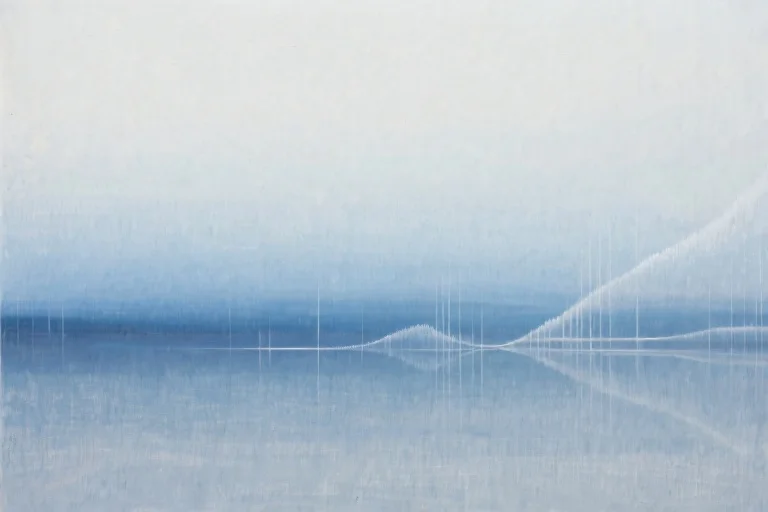The glow of your laptop screen burns into the darkness of another late night. Your fingers hover over the keyboard, mechanically refreshing the inbox for the third time in fifteen minutes. Somewhere between the 47th Slack notification and your boss’s midnight email marked ‘URGENT’, you catch your reflection in the blackened window—a stranger with your face, wearing an expression you don’t recognize.
Recent studies show the average knowledge worker now engages in over 120 digital interactions daily, each ping and vibration fracturing attention into increasingly smaller shards. We’ve become masters of split-screen existence: composing meeting notes while ‘listening’ to our partner’s day, scrolling through Instagram during yoga class, drafting replies in our heads during showers. This constant partial attention comes at a cost neuroscientists call ‘cognitive backlog’—the psychic toll of perpetually postponed presence.
What if healing begins not with doing more, but with strategically disappearing? Not as surrender, but as the ultimate reclamation. That moment when your reflection becomes unfamiliar isn’t weakness—it’s your psyche sounding the alarm. The art of strategic withdrawal isn’t about dropping out of life; it’s about temporarily stepping away from the versions of yourself that no longer fit.
Consider this your formal permission: disappearing isn’t failure. Those phantom vibrations in your pocket, the compulsion to document rather than experience, the way your laughter sometimes sounds like a poorly dubbed film—these aren’t personal shortcomings but symptoms of living inside systems designed to keep you engaged at all costs. Digital minimalism isn’t radical; it’s the sanest response to an insane paradigm.
True strength sometimes wears the face of stillness. When every algorithm rewards perpetual motion, choosing to stop becomes revolutionary. Your devices will keep breathing without you. Colleagues will solve problems in your absence. The world, astonishingly, continues turning. And when you return—not because inboxes demand it, but because your thoughts finally feel like your own again—you’ll bring something more valuable than your availability: your undivided self.
The Fractured Digital Self
You know that moment when you catch your reflection in a phone screen and barely recognize the face staring back? The eyes slightly glazed from switching between seven conversations, the smile that doesn’t quite reach where it used to? That’s your digital self taking over – a performance artist trapped in an endless audition.
Social media transformed personal expression into a high-stakes talent show. We’ve developed what psychologists call ‘context collapse’, where every post becomes a carefully staged exhibit for simultaneous audiences: your college roommate, potential employers, your mother-in-law. The average user maintains 3.4 distinct online personas according to Stanford’s Digital Identity Lab. That’s three complete wardrobes of personality traits we’re constantly changing between before breakfast.
The attention economy thrives on this fragmentation. Those red notification dots aren’t just reminders – they’re neurological slot machines triggering dopamine hits that make lab rats look disciplined. A 2023 Cambridge study found smartphone users check devices 58 times daily, with 30% occurring during face-to-face conversations. We’ve become walking split-screen experiments, half-listening to real humans while composing witty email signoffs in our heads.
Multitasking is the ultimate con. What we call ‘productivity’ is actually cognitive backflips that leave us dumber – the mental equivalent of trying to digest five meals simultaneously. Neuroscientists confirm task-switching burns glucose at rates comparable to solving advanced algebra. No wonder you feel exhausted after a day of ‘just checking messages’ between Zoom calls.
Here’s what they don’t tell you about digital fatigue: it’s not the screen time that breaks us, but the constant self-editing. The mental gymnastics of being ‘workplace professional’ in Slack, ‘inspirational friend’ on Instagram, and ‘concerned citizen’ on Twitter before dinner. We’re not designed to be human Swiss Army knives – some parts always get dull from overuse.
Your phone’s most dangerous feature isn’t radiation or blue light. It’s the invisible expectation that you’ll perform 24/7 without an intermission. Those three typing dots in messaging apps have become digital shackles, creating what communication researchers call ‘response panic’ – the visceral dread when you see someone has seen your message but haven’t replied. We’ve internalized the tyranny of immediacy so completely that taking three hours to answer feels like a moral failing.
This isn’t just about distraction. It’s about disintegration – the slow crumbling of your unified self into algorithmic-approved fragments. When your LinkedIn profile starts feeling more ‘real’ than your shower thoughts, when you mentally compose tweets during intimate conversations, that’s when you need to ask: who’s left when all the performances end?
The first step to digital wellness isn’t another app or hack. It’s recognizing that your most authentic self might be the one not posting, not replying, not performing. The you that exists between status updates. The version that doesn’t need filters or strategic hashtags. That person still exists – they’re just buried under layers of digital drag.
Next time your phone buzzes with another demand, try this radical act: imagine your attention as physical space. Would you let strangers barge into your living room 58 times daily? Would you allow coworkers to scribble on your bedroom walls? We treat our mental real estate with less respect than a cheap rental apartment. No wonder we feel homeless in our own minds.
The Right to Disappear: A Defense of Strategic Withdrawal
Your phone buzzes with another notification as you stare at the screen, your eyes glazing over. That familiar hollow feeling creeps in—when you realize the person typing emoji-laden replies isn’t really you, but some exhausted approximation. Modern life demands this strange ventriloquism, where we throw our voices into digital voids while our true selves grow quieter.
Neuroscience confirms what your bones already know: constant connectivity fractures cognition. The brain’s default mode network—responsible for self-reflection and creative insight—only activates during uninterrupted downtime. A 2023 Cambridge study found that subjects who practiced digital detox showed 27% greater problem-solving abilities. Your mental white space isn’t luxury; it’s biological necessity.
Philosophers have long championed disappearance as homecoming. Heidegger’s concept of ‘dwelling’ suggests we become most ourselves not through perpetual engagement, but in contemplative withdrawal. Contemporary digital minimalism builds on this, framing offline intervals as radical acts of self-preservation. When you mute notifications to watch leaves tremble in wind, you’re practicing existential hygiene.
The attention economy monetizes your absence of absence. Social platforms engineer endless scroll to exploit dopamine loops, while workplaces normalize 24/7 availability through slack messages that bleed into bedtime. Economist Herbert Simon warned: ‘A wealth of information creates a poverty of attention.’ Your unpaid cognitive labor fuels trillion-dollar industries—yet you apologize for needing respite?
Three defenses for your disappearance:
- Biological Imperative: Your prefrontal cortex needs offline periods to consolidate memories and regulate emotions. Those ‘unproductive’ hours staring at clouds are actually neural housekeeping.
- Philosophical Sanctuary: From Buddhist retreats to Thoreau’s Walden, disappearing acts have always been sacred counterpoints to societal noise.
- Economic Resistance: Every email ignored and tweet unseen reclaims slivers of your cognitive real estate from corporate colonizers.
You’ll encounter protest. Colleagues may mistake boundaries for betrayal; friends might pathologize your silence. Remember: their discomfort with your absence often reveals their own unease with stillness. As psychiatrist Carl Jung observed, ‘Loneliness doesn’t come from having no people around, but from being unable to communicate what matters.’
Strategic disappearance isn’t rejection of connection, but deeper communion—with yourself first. When you temporarily dissolve digital identities, what remains isn’t emptiness, but the quiet pulse of authentic being. That’s not retreat; it’s homecoming.
The Three-Tiered Disappearance Plan
The 72-Hour Sensory Reset
Begin with this radical permission: your devices can wait. For the next three days, treat your attention like a recovering patient in convalescence. Start by disabling all non-essential notifications—not just muting, but physically navigating to each app’s settings to sever the digital IV drip. The act of manual disconnection itself becomes the first ritual of reclaiming agency.
Create designated “device resting zones” in your home—a drawer, a closet shelf, anywhere that requires physical movement to access. When the itch to check arises, observe the impulse like a curious scientist: “Interesting, my thumb just twitched toward where the phone usually lives.” Replace the reflex with a tangible alternative—a paperback novel with dog-eared pages, a sketchpad with charcoal smudges, anything that leaves tactile evidence of time spent differently.
The Weekly Blank Afternoon
Wednesday afternoons or Sunday mornings—choose a recurring 4-hour window where you implement “analog rules.” This isn’t mere screen avoidance; it’s active cultivation of cognitive quietude. Prepare as you would for a mini-vacation: set auto-responders mentioning “delayed replies during focus hours,” pre-write any truly urgent communications, then power down completely.
The magic happens in the transition period. For the first twenty minutes, you’ll mentally thrash like a fish on shore—half-formed thoughts about unchecked emails darting through your mind. Then comes the breakthrough: your brain begins mining deeper cognitive layers normally drowned out by pings. Keep a notebook handy for these unearthed thoughts, not as productivity trophies but as proof of your mind’s native richness when undisturbed.
Customized Digital Fasting
For those needing deeper restoration, design your own disappearance template. Perhaps it’s deleting all social apps for a lunar cycle while keeping messaging platforms active with adjusted expectations (“Responding weekly”). Maybe it’s installing a minimalist phone launcher that reduces your device to call/text functions only. The key lies in intentional deprivation—removing not just time-wasters but the very architectures of interruption.
Build re-entry protocols before you begin. Schedule a calendar event labeled “Potential Return Date” with three self-check questions: 1) Has my sleep stabilized without sleep trackers? 2) Do mundane moments (boiling tea, watching rain) spark unforced curiosity? 3) Can I envision reconnecting without dread? Your answers determine whether to extend the fast.
The Disappearance Spectrum
These tiers aren’t sequential steps but overlapping strategies—sometimes you’ll need a monthly blank weekend sandwiched between weekly resets. The throughline remains: disappearance isn’t about escaping life, but returning to the version that doesn’t treat rest as stolen time. When done right, you’ll start noticing subtle shifts—how your breathing syncs with tree branches outside the window, how silence between friends feels nourishing rather than awkward, how your devices gradually transform from masters back into tools.
True digital minimalism isn’t measured in screen time reports but in the expanding gaps between impulse and action. Each disappearance, whether seventy-two hours or seventy-two minutes, rewires the Pavlovian connections forged by persistent connectivity. You’re not just taking breaks—you’re conducting a quiet revolution against the tyranny of perpetual presence.
The Body’s Quiet Language
There comes a morning when you wake without an alarm. Not because you forgot to set one, but because your body has remembered its rhythm. Your eyes open to sunlight instead of screenlight, and for the first time in months, you’re hungry for breakfast rather than caffeine. These are your physiology’s way of whispering: We’re coming home.
The Physical Compass
Your sleep patterns become the most honest diagnostic tool you own. When 2AM email checks shift to 10PM book-reading, when five snooze buttons become one stretch and a yawn—that’s your nervous system shedding the armor of hypervigilance. Track not with apps, but with simple observations: the weight of your eyelids at dusk, the unforced breath upon waking.
Digestion too tells secrets your mind has ignored. That sandwich tasting like more than cardboard? The sudden craving for your childhood favorite fruit? These aren’t random. They’re somatic markers cutting through the noise of shoulds, pointing toward what your body actually needs.
The Emotional Barometer
You’ll notice it first in small moments. Humming along to a shop’s background music. Smiling at a dog’s goofy gait. These unscripted flickers of joy—untethered to likes or productivity—are your psyche’s all-clear signals. Unlike performative laughter that leaves your cheeks sore, these micro-delights generate warmth that lingers in your sternum long after.
Keep a simple log if words help: not mood ratings, but concrete experiences. Noticed dandelions pushing through pavement. Felt curious about cloud shapes. Wanted to dance in kitchen. The more specific, the better you’ll discern authentic contentment from habituated busyness.
The Social Mirror
Here’s the paradox: as you reconnect with yourself, others’ opinions grow both clearer and lighter. That text left unanswered for days no longer claws at your ribs. Colleagues’ offhand remarks land as their business, not yours. This isn’t indifference—it’s the quiet strength of recentered boundaries.
Test it gently. Share one unfiltered thought where you’d normally people-please. Observe: did the earth stop spinning? Often, the imagined social catastrophe was just a paper tiger, its power borrowed from your own exhaustion.
The Homecoming Checklist
- Body → Wakes and rests without rebellion
- Heart → Finds pleasure in uncurated moments
- Social → Engages from choice, not obligation
These signals won’t arrive on schedule. They’ll slip in like old friends letting themselves in with a spare key. When they do, trust their timing over any calendar. Your healing wasn’t on deadline; neither is your return.
The Silent Symphony of Return
Your phone lies face down on the coffee table, no longer vibrating with the urgency of a cardiac monitor. The laptop lid stays shut, its glow extinguished like stage lights after the final act. These devices we carry everywhere—they’re instruments, not appendages. You can set down the violin when the concerto ends. The music will wait.
Coming back isn’t about logging in. It’s about noticing how the morning light makes patterns on your bare walls without you framing it for Instagram. It’s your toes curling into carpet fibers during a stretch, the kind you never post about because no one ‘likes’ mundane miracles. The world kept spinning during your absence, but something shifted in its axis—you stopped mistaking availability for value.
When you’re ready (not when your guilt says you should be), reentry happens in breaths, not plunges:
- The first sip test – Can you drink tea without photographing the steam?
- The notification litmus – Does a text message trigger curiosity instead of cortisol?
- The scroll reflex check – Do you reach for your phone like a phantom limb, or like choosing a book from a shelf?
Here’s the secret they don’t put in productivity hacks: Digital minimalism isn’t deprivation. It’s realizing most ‘urgent’ pings have the lifespan of soap bubbles. That coworker who demanded immediate responses? They survived your radio silence. The group chat that exploded with memes? The humor fossilized by the time you saw it.
Try this reconnection ritual: Open your email client and delete—without reading—everything older than three days. Notice how your shoulders drop when you prove to yourself that emergencies don’t come via inbox. The sky remains firmly overhead.
You’ll know this experiment worked when a notification arrives and you smile instead of tense. When you leave your phone charging in another room during dinner not as a ‘digital detox challenge,’ but because the pasta smells better than your screen looks. The devices become tools again, not oxygen tanks.
Now make your final gesture: Press the power button on this article. Walk away before reading another ‘how-to.’ The best proof of healing isn’t consuming more advice—it’s trusting you already know how to be.
(Your hand hovering over the mouse right now? That’s the first note of your new symphony.)





